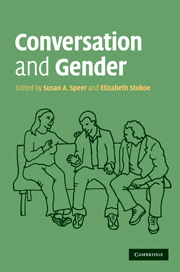Book contents
- Frontmatter
- Contents
- Contributors
- Data and transcription
- 1 An introduction to conversation and gender
- Part I Gender, person reference and self-categorization
- 2 The gendered ‘I’
- 3 Categories in talk-in-interaction: Gendering speaker and recipient
- 4 Doing gender categorization: Non-recognitional person reference and the omnirelevance of gender
- Part II Gender, repair and recipient design
- Part III Gender and action formation
- Part IV Gender identities and membership categorization practices
- References
- Author index
- Subject index
3 - Categories in talk-in-interaction: Gendering speaker and recipient
Published online by Cambridge University Press: 05 June 2012
- Frontmatter
- Contents
- Contributors
- Data and transcription
- 1 An introduction to conversation and gender
- Part I Gender, person reference and self-categorization
- 2 The gendered ‘I’
- 3 Categories in talk-in-interaction: Gendering speaker and recipient
- 4 Doing gender categorization: Non-recognitional person reference and the omnirelevance of gender
- Part II Gender, repair and recipient design
- Part III Gender and action formation
- Part IV Gender identities and membership categorization practices
- References
- Author index
- Subject index
Summary
Introduction
Social scientists and linguists have sometimes written about ‘men's talk’ (Coates, 2003), ‘women's talk’ (Coates, 1996), ‘lesbians’ talk' (Morgan & Wood, 1995) or ‘gay men's talk’ (Leap, 1996) as though the fact that the speakers whose talk is being analysed are men, or women, or gay is sufficient warrant for analysing their talk as such. But, as Schegloff (1997, following Sacks, 1972) has famously pointed out, any given individual can be characterized by a wide range of category terms taken from many different category sets, including, for example, gender, sexuality, political alignment, ethnicity, age, nationality, religion, occupation, place of residence, health status, family position and so on. One consequence of this is that we cannot explain the selection of any given category term simply ‘by saying that they are, after all, such a one’ (Schegloff, 1997: 165). The speaker who is a ‘woman’ is also, for example, a lesbian, a Pagan, an environmentalist, a diabetic, a sister and so on. There is always a range of different characterizations of any one person, all of which are equally ‘true’.
Since Schegloff (1997) highlighted the analytical implications of speakers' multiple category memberships, there has been a concerted effort to locate analytic criteria on the basis of which a speaker can legitimately be heard to be speaking as a member of one category rather than another (e.g., Antaki & Widdicombe, 1998; Kitzinger, 2000a; 2006; 2007b; Speer, 2005b; Stokoe, 2005; Wilkinson & Kitzinger, 2003; 2007).
- Type
- Chapter
- Information
- Conversation and Gender , pp. 48 - 63Publisher: Cambridge University PressPrint publication year: 2011
- 1
- Cited by



